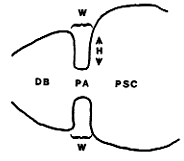


Go to chapter: 1 | 2 | 3 | 4 | 5 | 6 | 7 | 8 | 9 | 10 | 11 | 12 | 13 | 14 | 15 | 16 | 17 | 18 | 19 | 20 | 21 | 22 | 23 | 24 | 25 | 26 | 27 | 28 | 29 | 30 | 31 | 32 | 33 | 34 | 35 | 36 | 37 | 38 | 39
Chapter 11 (page 44)




Go to chapter: 1 | 2 | 3 | 4 | 5 | 6 | 7 | 8 | 9 | 10 | 11 | 12 | 13 | 14 | 15 | 16 | 17 | 18 | 19 | 20 | 21 | 22 | 23 | 24 | 25 | 26 | 27 | 28 | 29 | 30 | 31 | 32 | 33 | 34 | 35 | 36 | 37 | 38 | 39
Chapter 11 (page 44)
| Fig. 11.1. Radiograph of normal pyloric ring (arrow) in motor quiescent phase of interdigestive myoelectric complex |  |
 | Fig. 11.2. Diagram of pyloric ring in motor quiescent phase. W, width; H, height; DB, duodenal bulb; PA, pyloric aperture; PSC, pyloric sphicteric cylinder |
The inner margin of the ring surrounds the pyloric aperture, i.e. the opening by which
the lumen of the stomach communicates with that of the duodenum. In the motor
quiescent phase the diameter of the aperture varied from 5.0 to 13.0mm, with a mean
of 8.7mm. The mean diameter of the sphincteric cylinder was 57.1mm, and the mean
diameter of the duodenal bulb 35.8mm. (Comment: Owing to magnification factors
the real measurements will be approximately four-fifths of the figures given).
Table 11.1 Radiographic measurements during the motor quiescent phase of the
interdigestive complex
| Case | Width of ring (mm) | Height of ring (mm) | Diameter Aperture | Diameter sphincteric cylinder (mm) | Diameter duodenal bulb (mm) |
| 1 | 4.0 | 15.0 | 11.0 | 60.0 | 45.0 |
| 2 | 5.0 | 13.0 | 10.0 | 61.0 | 38.0 |
| 3 | 6.0 | 11.0 | 6.0 | 54.0 | 26.0 |
| 4 | 4.0 | 11.0 | 6.0 | 64.0 | 30.0 |
| 5 | 7.0 | 14.0 | 11.0 | 50.0 | 40.0 |
| 6 | 8.0 | 13.0 | 13.0 | 74.0 | 40.0 |
| 7 | 3.0 | 5.0 | 6.0 | 60.0 | 50.0 |
| 8 | 3.0 | 11.0 | 10.0 | 40.0 | 35.0 |
| 9 | 4.0 | 6.0 | 9.0 | 45.0 | 26.0 |
| 10 | 3.0 | 12.0 | 5.0 | 63.0 | 28.0 |
| Average | 4.70 | 11.1 | 8.7 | 57.1 | 35.8 |
Previous Page | Table of Contents | Next Page
© Copyright PLiG 1998